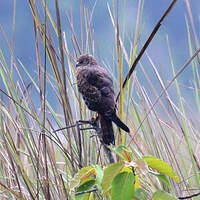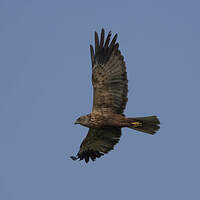African Marsh Harrier
Circus ranivorus - Busard grenouillard
Identification
The African Marsh Harrier is smaller than its European cousin, the Marsh Harrier, with a darker brown cap lightly sprinkled with white. The coverts and chin are noticeably lighter with variable grey shades, or even dirty white. The beak is yellow at the base with a black tip, and a yellow eye ring encircles a black eye. The brown throat is marked by a thin white collar which is characteristic of many harriers, such as the Marsh Harrier and Montagu's Harrier. The brown-black chest is streaked with lighter stripes, even white stripes in some individuals, which extend down to the belly. Juveniles look quite different, with a dark brown chest and belly marked by a characteristic white badge. The upper wings remain brown and are marked by a thin white line on the shoulder, whereas the primary feathers are striped grey and black, unlike those of the Marsh Harrier, which have white primary feathers in the female and darker brown in the male. The tail rectrices are also striped grey and black. When in flight, one can clearly make out the grey-black striped primary feathers, whereas all the other feathers remain brown or beige, depending on the individual.
A slight dimorphism exists between the male and female, with the female being larger and showing darker shades of brown on the brown parts. The tibias are covered with brown feathers and the tarses are yellow.
Subspecific information monotypic species
Foreign names
- Busard grenouillard,
- Aguilucho lagunero etiópico,
- tartaranhão-dos-pântanos,
- Froschweihe,
- békászó rétihéja,
- Afrikaanse Bruine Kiekendief,
- Albanella africana,
- grodkärrhök,
- Afrikasivhauk,
- kaňa žabožravá,
- moták africký,
- Afrikansk Rørhøg,
- afrikansuohaukka,
- Afrikaanse Paddavreter (Afrikaanse Vleivalk),
- arpella africana,
- błotniak afrykański,
- Африканский болотный лунь,
- アフリカチュウヒ,
- 非洲泽鹞,
- grodkärrhök,
- 非洲鷂,
Voice song and call
Habitat
Behaviour character trait
Dietfeeding habits
The French name is certainly more evocative than the Anglo-Saxon name: African Marsh Harrier, to think that the African Marsh Harrier only eats frogs! In fact not at all; its diet is wide: frogs, of course, but also all rodents, one sees it commonly hunting all kinds of birds, in particular the waterfowl, jacanas It will not refuse to plunder the nests and eat the eggs or attack the fledglings, from time to time it will be a scavenger.
It hunts by gliding slowly at medium altitude above the marsh, accelerating at the last moment and catching its prey in flight or diving to the ground on the rodents.Reproduction nesting
African Marsh Harrier can breed almost all year round in dry regions, particularly in South Africa, but the peak periods will be more specific in countries such as Kenya: June-July. They build their nest or rather a platform made with branches, reeds and grass, and often use the reeds found near wetlands. Usually, 3 to 4 eggs are incubated for 31 to 34 days. The chicks leave the nest after about forty days.
Geographic range
Threats - protection
IUCN conservation status
concern
in the Wild
threatened
evaluated
The African Marsh Harrier (Busard grenouillard) is generally not considered to be in danger, but other factors like reducing habitat are increasingly having an impact on this magnificent species. It is estimated that each pair requires around 100 hectares' of territory, of which a large portion must be a marsh area. Population growth and farming has, however, reduced its habitats, leading to a reduction in numbers. Traces of DDT have recently been found in eggs; sadly, many of these eggs don't survive to hatch. South Africa has only recently become aware of this problem and has designated the African Marsh Harrier as Vulnerable. BirdLife International has also designated the East Caprivi area of Namibia, north of the Okavango Delta, as a key conservation site, which should go some way towards protecting it.
Sources of information
- IOC World Bird List (v15.1), Gill, F and D Donsker (Eds). 2025-12-07.
- Newman's Birds of Southern Africa, Kenneth Newman
- Vol. 2 - Handbook of the Birds of the World, Josep del Hoyo-Andrew Elliot--Jordi Sargatal
- ARKive, Christopher Parsons
- Avibase, Lepage Denis
- BirdLife International, BirdLife International
- Wikipédia, Wikipedia, The Free Encyclopedia
- Birds of Kenya and Northern Tanzania, Dale A Zimmerman, Donald A Turner, David J Pearson
- Birds of Southern Africa 3rd edition, Ian Sinclair
- Field Guide Birds of Southern Africa, Ian Sinclair
Other sources of interest
 Specification sheet created on
01/08/2023 by Anne et Gabriel Leboff
Specification sheet created on
01/08/2023 by Anne et Gabriel LeboffTranslation by AI Oiseaux.net
© 1996-2025 Oiseaux.net
- Accipitriformes
- Aegotheliformes
- Anseriformes
- Apodiformes
- Apterygiformes
- Bucerotiformes
- Caprimulgiformes
- Cariamiformes
- Casuariiformes
- Charadriiformes
- Ciconiiformes
- Coliiformes
- Columbiformes
- Coraciiformes
- Cuculiformes
- Eurypygiformes
- Falconiformes
- Galliformes
- Gaviiformes
- Gruiformes
- Leptosomiformes
- Mesitornithiformes
- Musophagiformes
- Nyctibiiformes
- Opisthocomiformes
- Otidiformes
- Passeriformes
- Pelecaniformes
- Phaethontiformes
- Phoenicopteriformes
- Piciformes
- Podargiformes
- Podicipediformes
- Procellariiformes
- Psittaciformes
- Pterocliformes
- Rheiformes
- Sphenisciformes
- Steatornithiformes
- Strigiformes
- Struthioniformes
- Suliformes
- Tinamiformes
- Trogoniformes



























